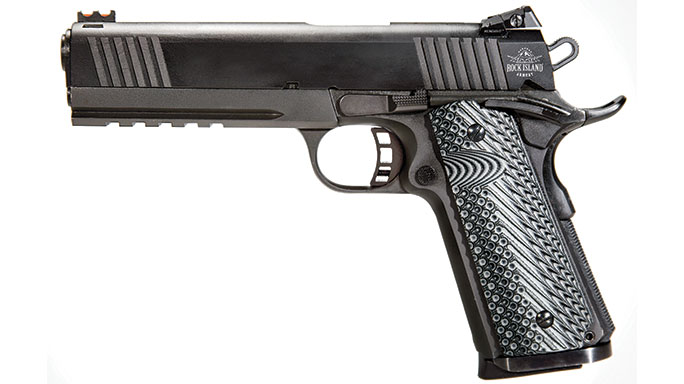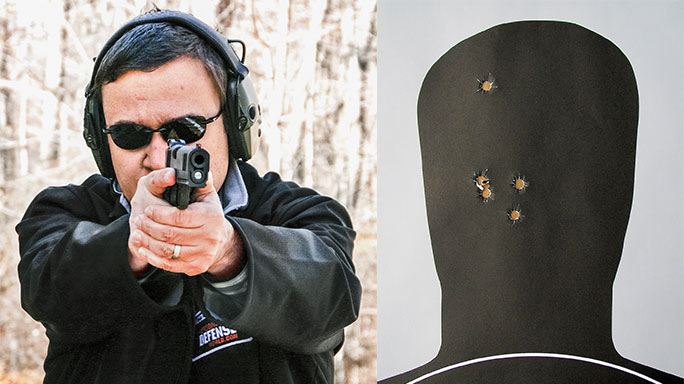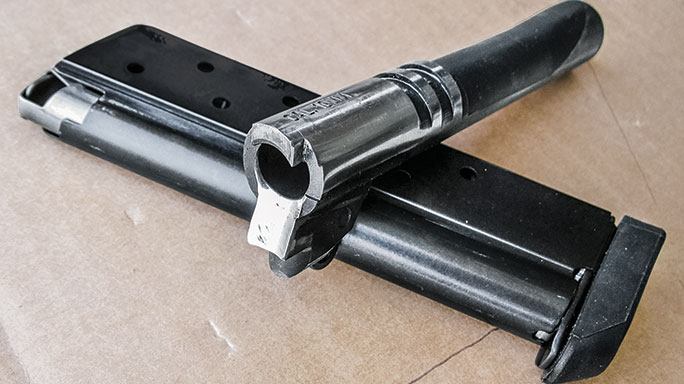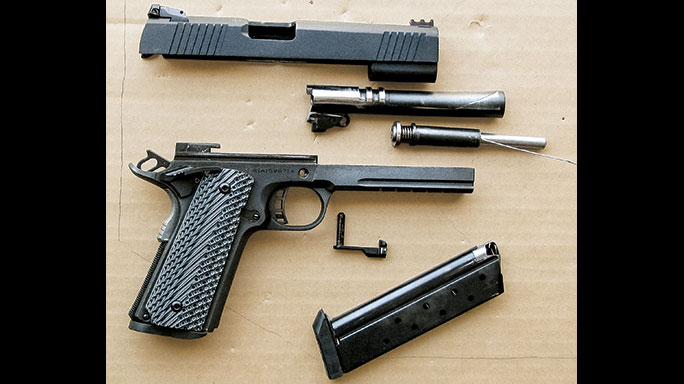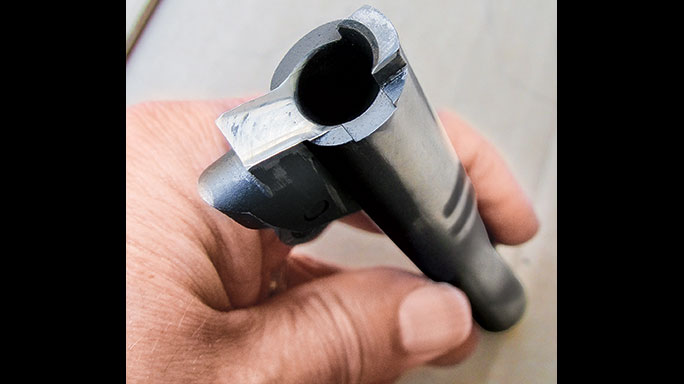Chamber the 1911 in 10mm and it can perform. The classic platform was designed for the .45 ACP, made to take about 21,000 psi with 230-grain ball ammunition. In the late 1920s, the gun was juiced up with the .38 Super, which has about 36,000 psi, depending on the load. Introduce the 1911 to the 10mm and you are talking about maximum pressure in the range of 37,500 psi. That’s enough to rattle the old pistol design, but not so with the Rock Island Armory TAC Ultra.
- RELATED VIDEO: Rock Island Goes Tactical with 2011 VZ Single Stack
Call me slightly prejudiced, but with every new 1911 I handle, one of the initial tests I perform is what I call the “rattle test.” I shake the pistol and listen for any loose-fitting parts. The TAC Ultra was dead silent. When I looked for any play between the slide and frame, there was nothing but a tight fit. The TAC Ultra is manufactured in Marikina City in the Philippines by Armscor. The 1911s from Armscor include value-priced GI 1911-style pistols. The TAC Series line raises the bar. The TAC Ultra in particular is equipped with all the features we come to expect in a 1911—an extended beavertail, an ambidextrous thumb safety and a magazine well funnel, to name a few.
The TAC Ultra uses a Series 70 system, so there is no internal firing pin safety like in the Series 80. Most 1911 purists, myself included, prefer the Series 70. The trigger feels cleaner and crisper than a system that uses the trigger to control the safety device like in the Series 80. The slide and slide stop are forged.
Advertisement — Continue Reading Below
The TAC Ultra uses a one-piece guide rod and bull barrel design that dispenses with the traditional barrel bushing. This setup enhances the accuracy of the pistol, and it also makes for a slightly different field-stripping procedure. When the pistol is in battery, the flared bull barrel locks up at the muzzle with a tight fit in the slide, and rear locking lugs lock into the inside of the slide like a typical 1911, making the pistol bank-vault tight. The barrel is stainless steel and has a built-in feed ramp like a Clark Custom barrel. The integral ramp fully supports the case so rounds feed directly onto the ramp; there is no gap between the frame and barrel for bullet noses to snag on.
The slide sports a subtle Armscor logo aft of the angled rear serrations; there are angled serrations at the muzzle end of the slide, too. The top of the slide is rounded like GI-style pistols. The front sight is dovetailed in place, and it has a tiny reddish orange fiber-optic tube that sucks up available light. In dim to dark conditions, the front sight is more difficult to see, but that is the nature of fiber-optic front sights. The adjustable rear sight is dovetailed into the slide and is radically dehorned. There’s not even a hint of a sharp edge on the rear sight, which features two white dots and a squared notch. The rear sight is flush with the rear of the slide for a maximized sight radius. A small flat-blade screwdriver and a sense of direction is needed to adjust the sights. There are no arrows to indicate sight adjustment direction, but for windage there are indicator marks that show left/right movement of the sight. The clicks were precise and gave confidence in the adjustments. In use, the sights are very good. They did not lose their zero even with the constant hammering of the 10mm loads.
“When I walked out to the target, I was smitten. The TAC Ultra clustered a magazine’s worth of bullets into an impressive group.”
Advertisement — Continue Reading Below
The frame has a full dust cover that allows for the attachment of a laser or light via a Picatinny-style rail. The railed portion of the receiver is beefed up, and the extra weight helps tame some of the 10mm’s recoil. Serrations on the frontstrap and a checkered polymer mainspring housing aid in gripping and controlling this beast. The upswept beavertail allows a higher grip on the pistol with no fear of hammer bite. The speed bump is also sized so that, even with a less-than-perfect grip, the grip safety will be disengaged. The skeletonized hammer offers plenty of grip to cock and decock the hammer, and the extended, ambidextrous thumb safety worked precisely with good positive clicks when flipped with your thumb. The trigger is also skeletonized and has long vertical serrations so your finger stays placed on the trigger. It is adjustable for overtravel via a small hex screw in the face of the trigger. The trigger had a slight bit of take-up and just a bit of creep before it broke. The trigger was good. It broke on average at 4.8 pounds.
The Operator II grip panels have an aggressive golf-ball pattern near their outer forward edges, near the frontstrap, and deep diagonal cuts toward the rear. A thumb recess allows easy and quick access to the magazine release for high-speed magazine reloads. At first glance, I thought the grips would be too aggressive for a 10mm, but they were not. Even after extended shooting, my palms were no worse for wear. The TAC Ultra also sports a magazine funnel that snaps onto the butt of the frame and is held down by the grip panel screws. The funnel—which requires basepads to be installed on the magazines so you can slam them home with the palm of your hand—sped up my reloads.
Two eight-round magazines are supplied with the pistol; both feature metal bodies and followers. I didn’t bust my thumbs loading these magazines, and both magazines came with rubber basepads installed. When seated, about 0.13 inches
of the basepad extend below the mag well. I like the almost-flush fit of the setup. The Parkerized finish over the entire pistol was well executed and understated.
Advertisement — Continue Reading Below
Range Time
Three brands of ammunition were used for range work: two training loads and a defense load. The training loads consisted of Federal’s American Eagle 180-grain FMJs and PMC Bronze 200-grain FMJ-TCs. I also used Federal’s Personal Defense rounds loaded with 180-grain Hydra-Shok JHPs. All of the ammunition cycled flawlessly through the TAC Ultra. For accuracy testing I placed a target at 25 yards and used my range bag as a rest. The TAC Ultra preferred the American Eagle load over the PMC, hands down. Always test a variety of ammunition in your weapon; you never know what brand or bullet weight it will perform better with, so do your due diligence. I know, I’m preaching to the choir.
When I fired the Federal cartridges, I had to lift my head and stare at the target. The shots felt good but I couldn’t see where they were hitting. When I walked out to the target, I was smitten. The TAC Ultra clustered a magazine’s worth of bullets into an impressive group. Six of the eight holes were touching; five created one large hole. “How much does this pistol cost?” I asked myself. Recoil with the TAC Ultra was very controllable. I think the extended dust cover helped to reduce muzzle flip and keep me on target. In rapid fire, the pistol cycled quickly, as you would expect with a round hot round like the 10mm. I needed hiking boots to retrieve the empty cases ejected from the pistol.
Advertisement — Continue Reading Below
- RELATED STORY: New For 2015: Rock Island Armory’s .22 TCM Bolt Action
I am not sure what the long-term effects of 10mm shooting will be on the Rock Island Armory TAC Ultra, but I am curious. Maybe I’ll need to keep it and find out.
For more information on the Tac Ultra, visit us.armscor.com or call 775-537-1444.
